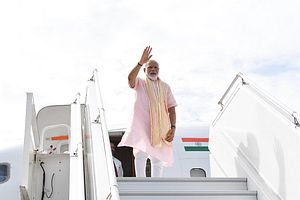Less than two weeks have passed since Narendra Modi’s swearing-in for a second term as India’s prime minister, but there’s already a palpable sense of expected continuity in India’s foreign policy approach. While Modi surprised observers with his appointment of former bureaucrat S. Jaishankar as his new external affairs minister, his diplomatic agenda in early June has been less surprising.
It began with the swearing-in ceremony itself, which departed subtly from the 2014 iteration in the regional leaders chosen for inclusion. Back then, Modi invited the heads of state and government from the South Asian Association for Regional Cooperation, or SAARC, to New Delhi. This time, another grouping was given prominence: BIMSTEC, or the Bay of Bengal Initiative for Multi-Sectoral Technical and Economic Cooperation. The grouping includes Bangladesh, India, Myanmar, Sri Lanka, Thailand , Nepal and Bhutan — all of whom (with the exception of Thailand and Myanmar) are SAARC members also.
The presidents of Bangladesh, Myanmar, and Sri Lanka attended, along with the prime minister of Nepal, the prime minister of Bhutan, and a Thai special envoy. Additionally, Sooronbay Jeenbekov, the president of Kyrgyzstan, and Pravind Kumar Jugnauth, the prime minister of Mauritius, attended. The emphasis on BIMSTEC reflects a shifting interest in New Delhi, focused on eastward connectivity and economic integration, following up on the iterative shift that the first Modi government had made, taking India’s old “Look East” policy and casting it in a more energetic “Act East” framing.
After the swearing-in, Modi wasted little time before preparing for overseas visits. On June 8 and 9, Modi jetted southwards from New Delhi to visit the Maldives and then Sri Lanka. Meanwhile, on June 7 and 8, Jaishankar traveled northeast, to the Kingdom of Bhutan, for his first overseas visit. Between Modi and Jaishankar, the focus on India’s neighborhood was unmistakable. In 2014, after his election, Modi had chosen Bhutan as his first overseas destination; this time, the choice of Maldives and Sri Lanka underscored New Delhi’s Indian Ocean interests too.
Between the leaders present at the swearing-in and the early high-level travel, a sense of India’s geographic priorities in its neighborhood are quickly becoming apparent. The Indian Ocean, the Himalayas, and Southeast Asia (by way of the Indian northeast) are the focus. Following the precipitous decline in India-Pakistan relations since late-2016, these trends had already been building.
With the Maldives, where a pro-India government has taken hold following a surprise election result last fall, New Delhi is particularly determined to seal in a strong bilateral relationship. Meanwhile, the relationship with Sri Lanka remains complex, and there’s an unmistakable uptick in India’s concerns about the security situation there after the deadly Easter Sunday terror attacks claimed by the Islamic State. To underscore this, Modi made an unscheduled detour to a bombed church in Colombo and underscored cooperation on counterterrorism with his Sri Lankan counterpart, Ranil Wickremsinghe.
What has been less palpable in these first few overseas interactions is a sense that India’s outreach in its neighborhood is being driven by concerns about China. While there are no doubt real anxieties in New Delhi underlying its approach to the neighborhood, in the Maldives, Sri Lanka, and Bhutan, India’s messaging has sought to affirm what these countries gain by engaging with it on their own terms.
More broadly, the message from New Delhi is clear: the “neighborhood first” approach is here to stay as Narendra Modi’s second term begins.

































